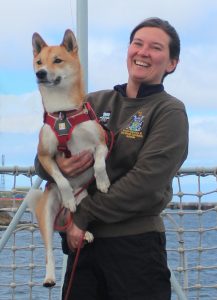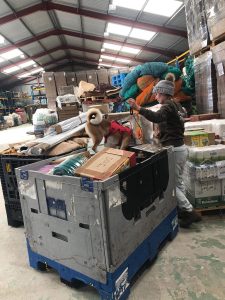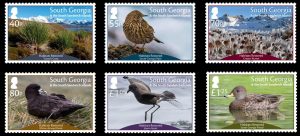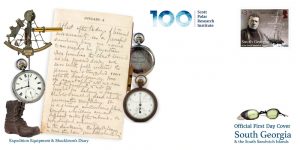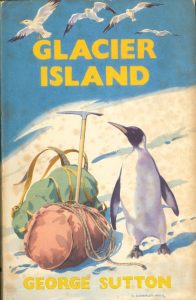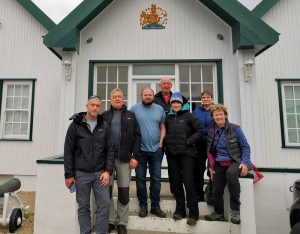The Government of South Georgia & the South Sandwich Islands (GSGSSI) commence a long-term biosecurity dog programme to prevent rats & mice from reaching South Georgia.
GSGSSI is delighted to announce the start of a new Biosecurity Dog Programme. This long-term programme follows intensive pilot studies and trials using specially trained rodent detection dogs to ‘sniff out’ rodents hiding on vessels or in cargo bound for South Georgia, and therefore to prevent them reaching South Georgia.
South Georgia was declared rodent-free in May 2018 following a £10 million habitat restoration programme led by the South Georgia Heritage Trust (SGHT). The new biosecurity dog programme is the best way to protect that legacy and to ensure that South Georgia remains rodent-free allowing native species rejuvenation.
Some species like the endemic South Georgia Pipit (the world’s southernmost songbird), are already showing signs of recovery in the absence of rats and mice. They are now a common sight on the mainland where they were once reduced to a few off-shore tussac islands.
To deliver this keystone project, the GSGSSI have established a relationship with Working Dogs for Conservation (WD4C) who will provide ongoing training and support to our locally- based handler Naomi Baxter, and her dog Sammy.
Naomi says “Training to become a dog handler with WD4C in Virginia USA was hard work, but I’m looking forward to putting what I have learned into practice, and incredibly satisfying to play a small part in protecting South Georgia.”
Naomi & Sammy will search all kinds of vessels from cruise ships to yachts, fishing vessels to fishery patrol vessels, minimising the risk of rats and mice ever reaching South Georgia again. These skills and capabilities will not only benefit South Georgia, and there are already plans to use the biosecurity dog team to help prevent rodents from being introduced to rodent-free areas within the Falkland Islands.
In September of this year, the Government welcomed over 40 scientists to Kew Gardens to share with others, mainly scientists who have recently worked on SGSSI, why South Georgia is so important to their work. It was a very successful morning with fascinating presentations from a broad range of disciplines bringing welcome focus to our discussions about the need, or not, for a science strategy as we look to preparing the 2021-2026 strategy. The presentations are now available to download. Helen Havercroft, CEO, would like to thank everyone for taking part in the successful event and hopes participants and audience gained as much from the experience as she did.
2019 Science Agenda – 12th September 2019 [.pdf, 0.3mb]
Glacial history and environmental change on South Georgia – Dominic Hodgson [.pdf, 4.7mb]
Collaboration on South Georgia – Colin Clubbe [.pdf, 1.6mb]
South Georgia Renaissance – a unique scientific opportunity – David Vaughan [.pdf, 3.2mb]
Large-scale conservation in the Southern Ocean – Penguin Watch – Dr Tom Hart [.pdf, 2.8mb]
Sealing Archaeology – Marcus Brittain [.pdf, 10.3mb]
Plant management on South Georgia – Rosemary Newton [.pdf, 3.6mb]
Does Methane matter? Gas seepage on the shelf of South Georgia – Katrin Linse, Gerhard Bohrmann & teams [.pdf, 6.2mb]
Microbial biodiversity and Environmental change – Anne D. Jungblut [.pdf, 20.9mb]
1.) Habitats Restored Stamps
The Habitats Restored stamp issue, which celebrates the recovery of the South Georgia environment following the removal of invasive species, is now available to buy online and in post office shops in South Georgia and the Falkland Islands.
Over the last 250 years, human activities have had a profound impact on the flora and fauna of South Georgia. Sealing began in the late 1700’s and expeditions often lived ashore for months at a time. So brutally efficient was their operation, by the early 1800’s the seal populations were depleted beyond economic viability and the sealers departed. Next came the whaling industry. Between 1904 and the 1960’s tens of thousands of whales were killed, with over 1,000 people employed on the island to process the catch. The seasonal movement of visiting people and vessels, and the importing of supplies and equipment, led to numerous invasive species including rats, mice, reindeer and a wide variety of plants being either accidentally or deliberately introduced.
Left unchecked, these invasive species could have had a devastating and irreparable effect on the South Georgia ecosystem. Invasive rodents consumed the eggs and young of native bird species decimating populations and in some cases completely excluding them. Reindeer trampled and grazed the fragile sub-Antarctic vegetation and the burrows of seabirds below collapsed. Non-native plants competed with slow growing native species changing the character and functioning of vegetation communities.
Over the last 10 years, South Georgia has played host to some of the largest habitat restoration projects undertaken anywhere on earth. The Government of South Georgia & the South Sandwich Islands and the Norwegian Nature Inspectorate completed a reindeer eradication programme that used a combination of herding and ground shooting to remove almost 7,000 reindeer from the island. In 2018 South Georgia was declared rodent free after the South Georgia Heritage Trust undertook a programme to eradicate rats and mice, using aerial distribution of bait from helicopters. The benefits of these habitat restoration projects are now being reaped and native bird and plant populations are thriving as never before. With the removal of grazing pressure from reindeer, many of the non-native plants thrived and are now the subject of an on-going weed management plan which aims to reduce 33 of the 47 non-native plants to zero population density by 2020.
40p Tussock grass – A staple of the terrestrial ecosystem, tussock grass provides nesting space for birds and habitat for numerous invertebrates. Although it is a tenacious species, grazing and antler rubbing saw many tussock bogs reduced to mossy stumps. Little by little, tussock and its many companion species are now reclaiming the coastal landscape of South Georgia.
55p South Georgia pipit – Endemic to the island, the South Georgia pipit is the only song-bird species in the Antarctic. In the presence of rodents the pipit was restricted to offshore islands and slivers of vegetation on the harsh south coast. Since the rodent eradication the pipit has made a remarkable recovery and now its cheerful song can be heard throughout the territory.
70p Greater burnet – A member of the rose family, with a prickly pink seed head, this annual herb thrives in moist nutrient rich habitats. Its soft leaves were a favourite food of reindeer and fast growing invasive plants outcompeted it for space in prime habitats. Happily, swathes of this iconic plant can now be seen in abundance.
80p White-chinned petrel –The white-chinned petrel relies on steep tussock covered slopes in which to build its underground nests. As reindeer stripped away vegetation the white-chinned petrel needed, and rodents predated its eggs, this shy bird was becoming an increasingly rare sight. With the removal of these non-native species, white-chinned petrels are becoming more and more common.
£1.05 Storm petrel – With its distinctive dangling legs, this tiny sea bird was previously rarely seen in South Georgia’s inshore waters. Nesting in rocky crevices near to the shore, it was a prime target for rodents. Now great flocks of these beautiful little birds can be seen dancing across the bays and inlets of the island.
£1.25 South Georgia pintail – An endemic subspecies, the South Georgia pintail nests in tussock fringed pools near to the coast. In the presence of rats and reindeer its numbers were depleted. Now its habitat has been restored, pintails are able to raise up to a dozen chicks a year and its distinctive ‘chirrup chirrup’ fills the evening air.
Visit https://www.falklandstamps.com/south-georgia-ssi-habitats-restored.irc to purchase stamps online
2.) Centenary of the Scott Polar Research Institute Centenary Stamp
Founded in 1920, as part of the University of Cambridge, the Scott Polar Research Institute (SPRI) is the oldest international centre for polar research within a university. The SPRI’s mission is to enhance the understanding of the polar regions through scholarly research and publication, educating new generations of polar researchers, caring for and making accessible its collections, and projecting the history and environmental significance of the polar regions to the wider community for public benefit. Scientific research in the Institute is focused on ice and environmental change in the polar regions.
£3.50 Stamp
This stamp commemorates the SPRI’s centenary and depicts Sir Ernest Shackleton with the Endurance, which took he and his crew on his third expedition to the Antarctic. Departing in 1914 Shackleton and his men intended to undertake the first crossing of Antarctica via the South Pole. The expedition was known formally as the Imperial Trans-Antarctic Expedition (1914-17) and informally as the Endurance Expedition after the ship. The Endurance became trapped in sea ice early in 1915 and ten months later was crushed and sank. Shackleton’s crew had already abandoned the ship to live on the floating sea ice. In April 1916, they set off in three small boats, eventually reaching Elephant Island. Taking five crew members, Shackleton went to find help. In a small boat, the lifeboat James Caird, the six men spent 16 days crossing 800 miles (1,300 km) of ocean to reach South Georgia. They arrived exhausted on the west side of South Georgia, and Shackleton, Frank Worsley and Tom Crean finally trekked across the mountainous island to Stromness whaling station to raise the alarm. The remaining men from the Endurance were rescued from Elephant Island in August 1916.
All the artefacts and the document pictured on the first-day cover envelope are preserved at the SPRI. The sextant (top left), chronometer (centre left) and stopwatch (bottom right of diary) were used by Frank Worsley, captain of the Endurance, to successfully navigate the James Caird lifeboat 800 miles across the Southern Ocean from Elephant Island to South Georgia, an achievement recognised as one of the greatest ever feats of small-boat navigation. Shackleton then returned to Elephant Island aboard the Chilean vessel Yelcho, captained by Luis Pardo, and rescued the remainder of the crew of the Endurance.
Shackleton later gave the chronometer to Worsley to commemorate the journey from Elephant Island. The inscription on the back (top right of diary) reads, ‘F.A. Worsley, from E.H. Shackleton, May 1916’.
The dark brown leather boot (bottom left) was designed by Sir Ernest Shackleton and used during the Endurance Expedition. On the right of the envelope, below the stamp, is a photograph of the goggles used by Shackleton on the same trip. The goggles were given to a Norwegian whaler when Shackleton reached South Georgia after his epic boat journey and were later gifted to the SPRI where they are displayed in the Institute’s Polar Museum.
The central image shows the final diary entry made by Sir Ernest Shackleton. It was written in South Georgia aboard the ship Quest, which was used for his 1921-22 Antarctic expedition. The diary entry reads:
4 January: At last after 16 days of turmoil and anxiety on a peaceful sunshining day we came to anchor in Grytvitken. How familiar the coast seemed as we passed down. We saw with full interest the places we struggled over after the boat journey. Now we must speed all we can but the prospect is not too bright for labour is scarce. The old smell of dead whale permeates everything. It is a strange and curious place. A wonderful evening. In the darkening twilight I saw a lone star hover: gem like above the bay.
Shackleton died shortly afterwards on 5 January 1922.
More information on the stamps can be found at www.pobjoystamps.com and the stamps are available to purchase through https://www.falklandstamps.com
Exploring new frontiers with our new polar ship.
The wharf at King Edward Point Research Station on South Georgia Island is being upgraded to berth the new UK polar research ship, the RRS Sir David Attenborough. It will enable the vessel to facilitate critical environmental research in the waters around South Georgia.
Antarctic science provides unparalleled opportunities to increase our understanding of planet Earth in the benefit of society. King Edward Point is owned by the Government of South Georgia and the South Sandwich Islands and operated by British Antarctic Survey (BAS). The station provides critical research to support sustainable fishing in this important location in the Southern Ocean and the waters around South Georgia are among the most sustainably-managed in the world.
Construction of the new wharf will take place from the end of January to June 2020. The works will be conducted in a manner in which disruption to every day operational, commercial and science delivery is minimalised. A comprehensive Environmental Impact Assessment for the construction of wharf has been completed and zoologists from BAS are monitoring the wildlife around the wharf to ensure no environmental harm occurs.
The RRS Sir David Attenborough will be a new research platform that will transform how ship-borne science is conducted in the Polar Regions. She is part of a major Government polar infrastructure investment programme designed to keep Britain at the forefront of world-leading research in Antarctica and the Arctic. This £200m commitment represents the UK Government‘s largest investment in polar science since the 1980s.
Heavy Fuel Oil Prohibition has been brought into force across the South Sandwich Islands following GSGSSI announcements in December 2018. No vessels have been permitted to use Heavy fuel Oil in the area identified in the Heavy Fuel Oil (Prohibition of Carriage and Use) Ordinance 2019 (No 5 of 2019) since last December. This will be extended to cover the whole of our Marine Protected Area (MPA) by 31 December 2020.
This is an important environmental enhancement to the GSGSSI MPA which was significantly enhanced and enlarged (to 1.24m km3) last December following the first 5 year independent review of the MPA.
GSGSSI has made amendments to the 2019 Customs Order to remove the distinction between yachts and other vessels. This will see an increase in the Customs Fees payable by yachts.
This change means that costs more accurately reflect effort involved in administering the Customs Ordinance. Whilst the changes have been in force for over a week, GSGSSI have chosen 1 November 2019 to implement the new rules for practical reasons.
[Source: South Georgia Heritage Trust (SGHT)]
Under the umbrella of the GSGSSI heritage strategy [pdf] and Conservation Management Plan for Grytviken [pdf], SGHT and FOSGI are hosting an international competition that will engage creative practitioners from varying artistic disciplines to develop a site-specific commission to celebrate the whale through a reinterpretation of the former Flensing Plan. This is an inspirational project, an opportunity to create a legacy for the future, a message of hope for the natural world and a reinterpretation that will challenge visitors to consider man’s changing relationship with nature and in particular with the whale.
The winning commission will be selected by a diverse panel representing GSGSSI, South Georgia stakeholders and the creative community; the chosen applicant(s) will create a creative intervention that will set the scene for visitors to Grytviken. Its purpose is to help visitors interpret Grytviken’s past and present and to celebrate the recolonization of whales, seals, seabirds and plant life, thanks to excellent British stewardship and environmental management of South Georgia’s terrestrial and marine environments.
This commission is part of a cultural heritage programme to communicate a poignant message about our changing attitudes to nature and the need for resolute stewardship of our oceans and the natural world.
More information on the application process here: http://www.sght.org/commission-grytviken-whaling-station-south-georgia/
A recently published paper, “The distribution, abundance, status and global importance of giant petrels (Macronectes giganteus and M. halli) breeding at South Georgia”, has highlighted the importance of these birds in a global context. The first complete archipelago-wide survey of breeding northern and southern giant petrels in the austral summers of 2005/06 and 2006/07 estimated that pairs of northern and southern giant petrels breeding at South Georgia represented 71.0% and 17.3%, respectively, of updated global estimates.
The increase in giant petrel numbers is an indicator of a healthy ecosystem, as it is likely influenced by the recovery of the Antarctic fur seal population and the large numbers of king penguins at South Georgia, which provide an abundant food resource. The paper did however note that the increase in giant petrel numbers may be putting increasing predation pressure on albatross at South Georgia, who are already struggling from the impacts of fishing fleets operating beyond the highly regulated waters of the SGSSI MPA.
Poncet, Sally; Wolfaardt, Anton C.; Barbraud, Christophe; Arriegas, Ronald A.; Black, Andrew; Powell, Robert B.; Phillips, Richard A. (2019). The distribution, abundance, status and global importance of giant petrels (Macronectes giganteus and M. halli) breeding at South Georgia. Polar Biology. https://doi.org/10.1007/s00300-019-02608-y
[Source: The Times Newspaper]
George Sutton, mountaineer, was born on June 22, 1923. He died on November 1, 2019, aged 96.
Meditative leader of a daring expedition to scale previously unconquered, ice-bound slopes on South Georgia.
This time Sutton and his comrades became the first group to enter the Sub-Antarctic region with mountaineering as their main goal. They hoped to scale previously unconquered, ice-bound slopes in the interior of the island. “In South Georgia there were whole ranges of virgin peaks,” Sutton wrote. “This mountainous island lay at the doors of Antarctica, that vast unplumbed territory where future mountaineers could climb for a hundred years and not exhaust its riches.”
The team succeeded in climbing many of the territory’s mountains, although they were beaten back by an icefall as they attempted to reach the summit of the formidable Mount Paget, which, at 9,629ft, is the greatest peak on South Georgia and twice the height of Ben Nevis. It would be another decade before this feat was achieved.
The full obituary can be read here.
Dundee charity launches artistic competition to tell whaling history of South Georgia
“A Dundee charity has launched an international art competition to relay the story of whales at Grytviken, on the sub-Antarctic island of South Georgia.”
Endurance diary on loan to Athy Museum
“A diary from polar explorer Sir Ernest Shackleton’s iconic Antarctic expedition has been donated to the museum in Athy.”
Antarctic environmental change and biological responses
“The continuing impacts of historical marine exploitation and other industrial activities are felt in parts of the Antarctic, particularly the sub-Antarctic islands and the northern maritime Antarctic (196, 197). On land, these primarily include the remains of onshore whaling stations, some of which were major industrial sites (198). Some, such as Grytviken (South Georgia) and Whaler’s Bay (Deception Island)”
‘Progressive Recovery’ of 25K South Atlantic Humpback Whales. In 1950s there were 450
“The whaling industry drove the western population of South Atlantic humpbacks right up to the precipice of extinction. The whales spend their winters in mating and calving grounds off the eastern coast of South America, then migrate to feeding grounds in the higher latitudes of the South Atlantic, near South Georgia and the South Sandwich Islands, for the summer months.”
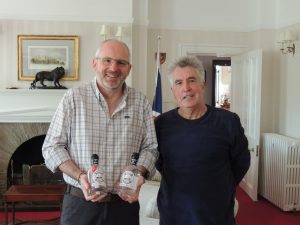
Presentation to the Commissioner of South Georgia & the South Sandwich Islands Nigel Phillips CBE, from Dr Robb Robinson from the Viola Trust. Presenting a Viola Trust Dry London Gin, message in a bottle signed by the Mayor of Hull (amongst many others), an autographed book Viola and a 2020 Viola Trust calendar.
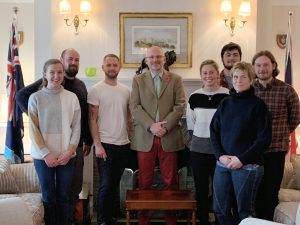
En-route to South Georgia, the new British Antarctic Survey wintering team meeting Commissioner Nigel Phillips.

Commissioner Nigel Phillips swears in BAS station leader Fran Pothecary as the South Georgia Magistrate.
Share[addtoany]


